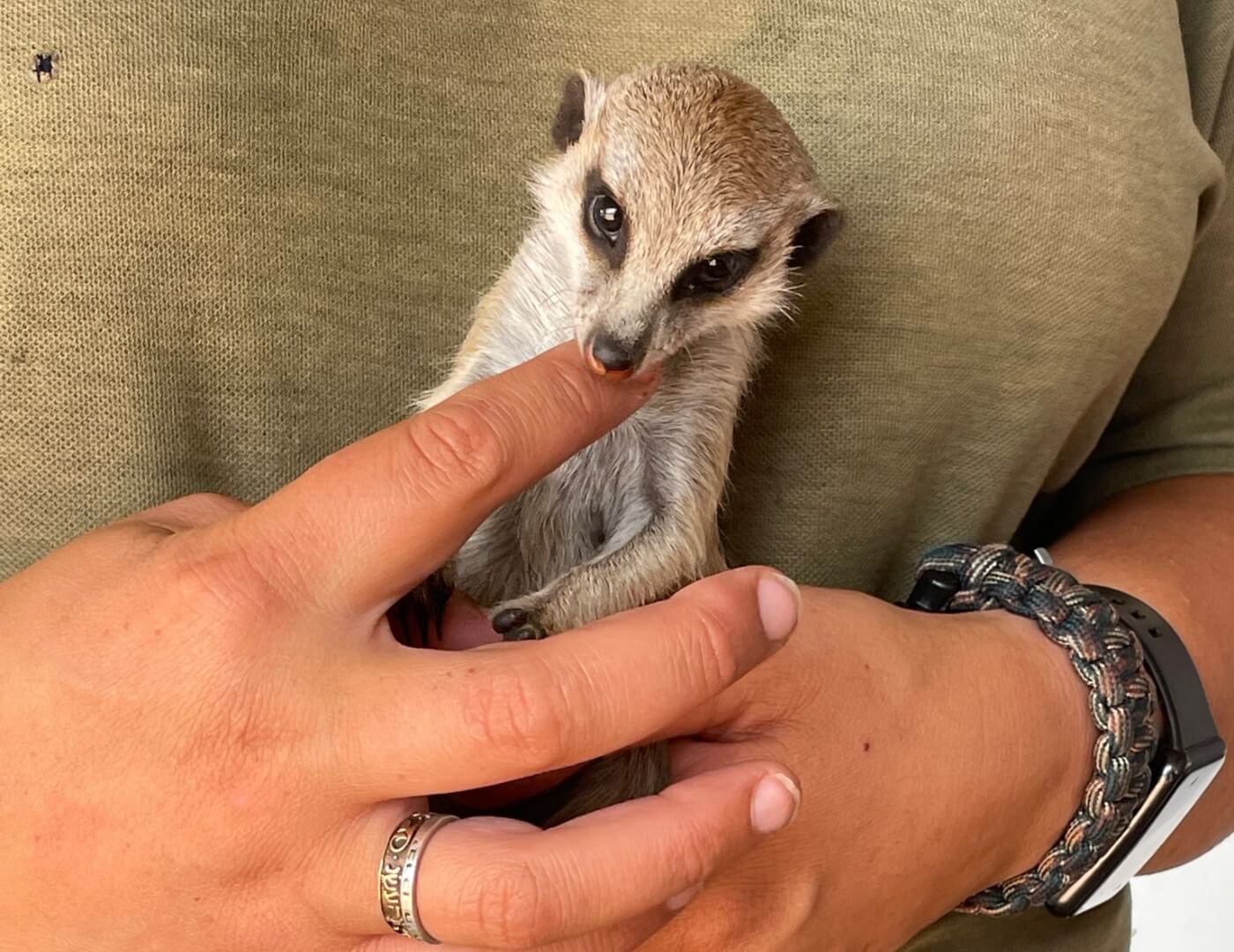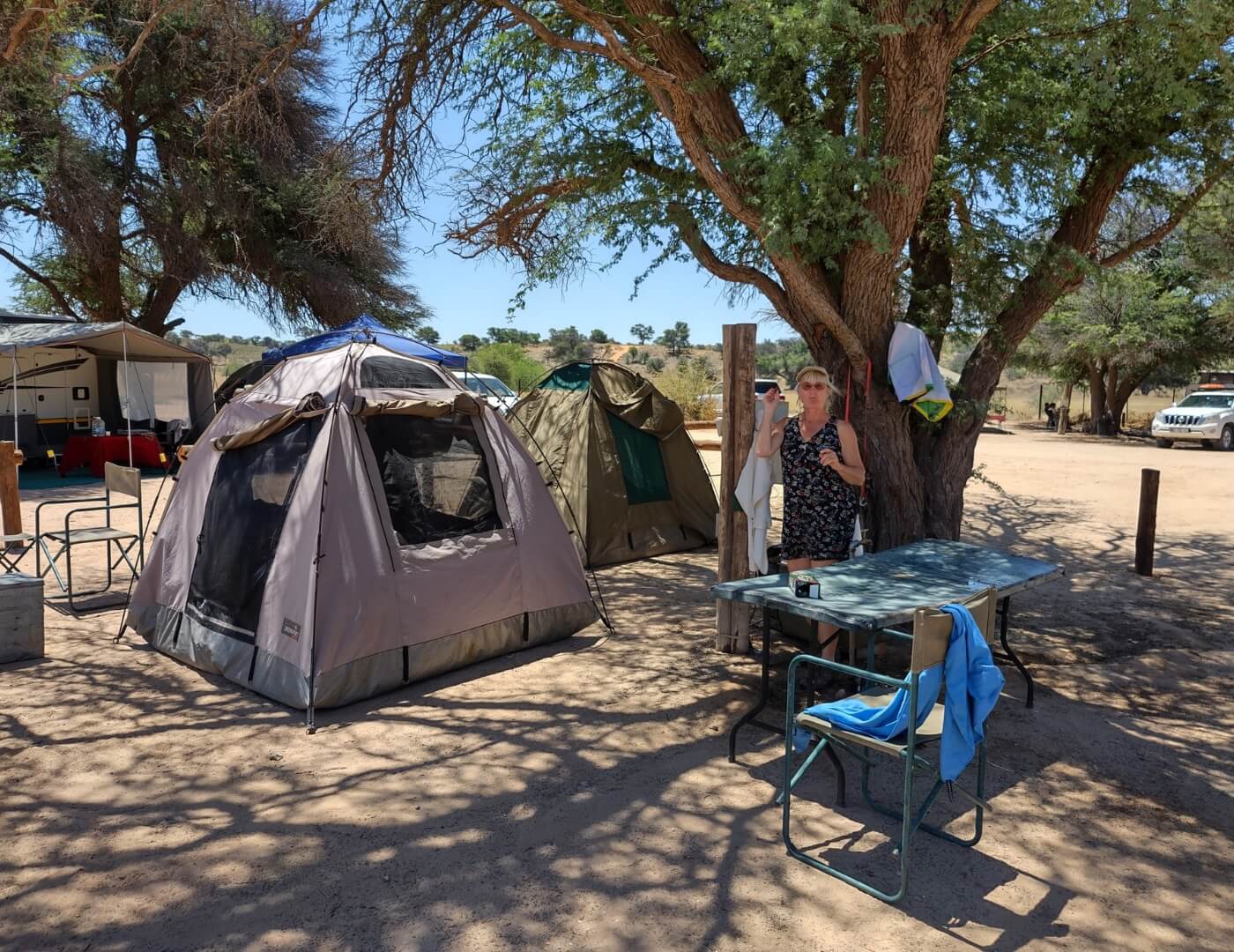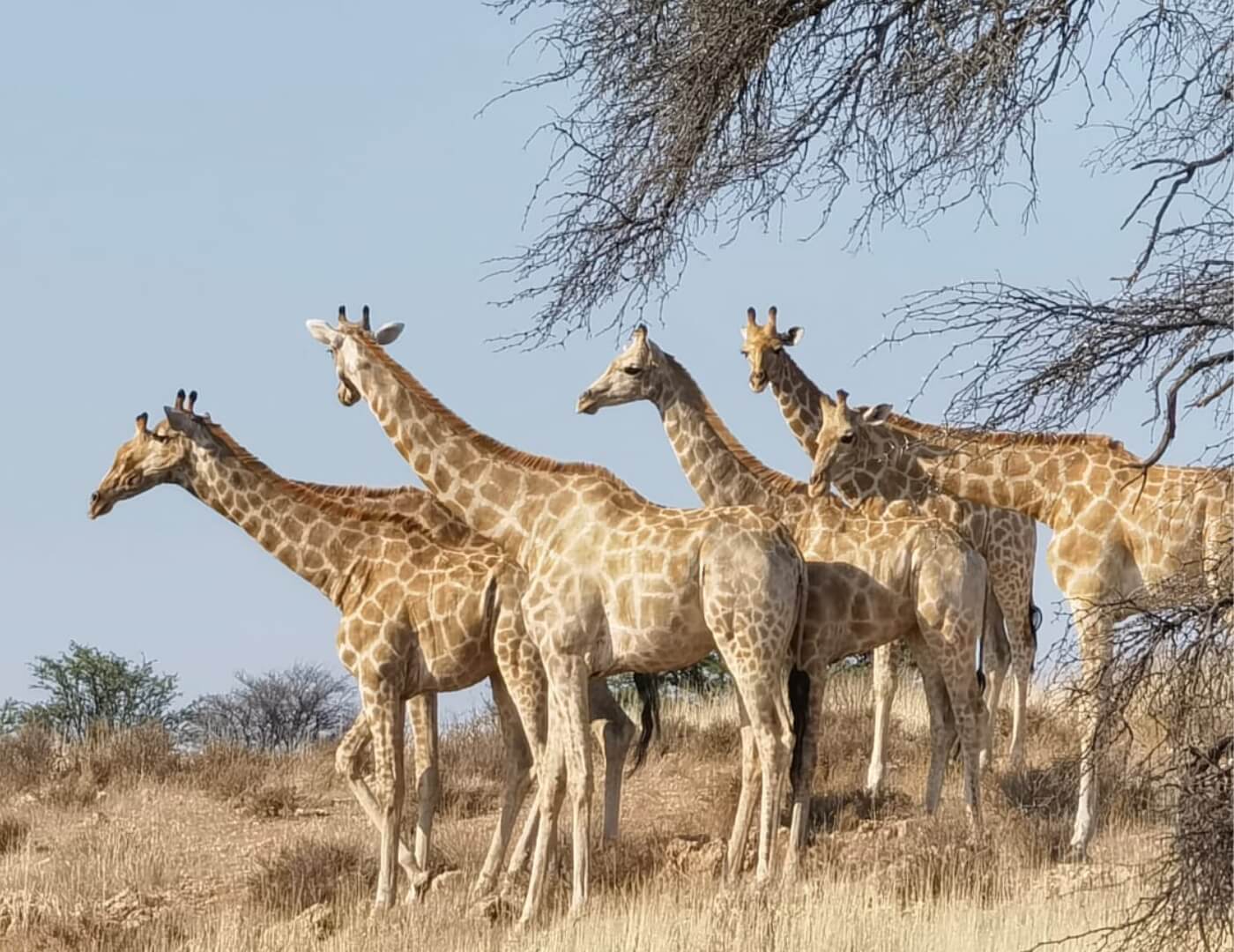Kgalagadi to Karoo
13 Days / 12 Nights
Malaria Free Area
Accommodation options: chalets/guesthouse.
This tour covers four National Parks and seven reserves/conservation areas.
Upington-Kgalagadi
DAY 1
We leave Upington at 8H30 from your guesthouse to drive to the Kgalagadi Transfrontier Park. Stop en route at the Norokei Salt Pans (natural salt mine) and the Khomani San Bushmen to view their art. Arrival at Twee Rivieren (12H30) Move into our lodge for a short rest. We depart on a game drive (speed limit 50km/h) in this 38 000 square km park until the gates close.
Approximate predator numbers: Lions – 450, Leopards – 150, Cheetah – 200, Spotted hyenas – 370. Bird species are 264, of which 20 raptor species are present. Antelope such as Gemsbok, Hartebeest, Springbok and Wildebeest are well represented. Optional 3-hour sunset- or night game drive with rangers in an open truck.
Overnight: Twee Rivieren chalet.
Meals: Light Lunch & Dinner.
DAY 2
Twee Rivieren – Nossob (160km).
Wake up one hour before gates open. Breakfast, then pack for Game drive in the dry riverbed. We do stalk driving (direction North-East) for 5 – 6 hours to reach Nossob. This is the day we try to learn more of the Kalahari and its secrets. Afternoon arrival. Check into lodge and short rest. Depart on a game drive until gates close. Special feature Nossob: Game hide with spotlight to watch animals coming to drink. Optional sunset drive with Rangers after gates closed.
Overnight: Nossob chalet.
Meals: Breakfast & Light Lunch & Dinner.
DAY 3
Nossob – Mata Mata.
Wake up an hour before gates open. Pack up and game drive towards Mata Mata, using the 70km long Dune Road to cross from Botswana to Namibia. Today we search for the famous Kalahari Lion, as well as the smaller inhabitants of the desert, like the Meerkat. Afternoon arrival at Mata Mata. Check in and short rest before we depart on another game drive to explore this area. Special feature Mata Mata: Game hide with spotlight, sunset drive with Rangers after gates closed.
Overnight: Mata Mata chalet / Kalahari Tented camp.
Meals: Breakfast & Light Lunch & Dinner.
DAY 4
Mata Mata – Kalahari Trails Nature Reserve.
Game drive from Mata Mata 130km to Twee Rivieren, check out and drive 30km to our next stop for the evening.
Overnight: Kalahari Trails guesthouse.
Meals: Breakfast Light Lunch & Dinner.
DAY 5
Kalahari Trails – Augrabies Falls National Park.
After an informative morning walk, we depart via Upington to visit the 6th highest Falls in the world – Augrabies. En route we stop at the Khomani Bushmen, Goera Salt Pan, Bezalel Wine Farm and Road stall.
Overnight: Augrabies chalet.
Meals: Breakfast & Light Lunch & Dinner.
DAY 6
Augrabies – Pofadder.
After a morning hike on the Dassie Nature Trail, as well as a last visit to the Falls, we proceed to Pofadder. This gravel road goes through the vast plains of the northern Bushmanland with views to the north of the Orange River Valley and the barren mountainous Southern Namibia.
Overnight: Pofadder Hotel.
Meals: Breakfast & Light Lunch & Dinner.
DAY 7
Pofadder – Niewoudtville.
Today we experience the scenic dirt roads through the western Bushmanland to Loeriesfontein, including the longest straight road in South Africa measuring more than 80km. This road takes one past remote sheep farms through one of the most sparsely populated areas in South Africa. At Loeriesfontein we visit the Windpump Museum.
Depart to Niewoudtville (situated on the Bokveld escarpment) On route we visit the largest Quiver Tree Forest in South Africa and the 110m high Niewoudtville Water Fall on the Doring River. Niewoudtville is known for its unique vegetation, with the biggest variety of bulbous plants in the world. This small town with its warm sandstone buildings is situated in a flat landscape covered by wheat, heather, and proteas due to higher rainfall close to the edge of the escarpment. During spring the area changes into a colourful carpet of spring flowers. 8 Km from town is a majestic view from the top of Van Rhyns Pass over the Knersvlakte.
Attractions: Wildflower Reserve on Glen Lyon with displays of over 500 000 endemic Bulbinella, Glacial Rock Striations from Permian era 280 million years ago, Khoisan Rock Paintings on Papkuilsfontein and the impressive NG Church built from sandstone.
Overnight: Guest House.
Meals: Breakfast & Light Lunch & Dinner.
DAY 8
Niewoudtville – Tankwa Karoo National Park.
Drive to Calvinia. Stop for a cup of tea at the historical Hantam House. Other interesting sites are South Africa’s largest Post Box and the well maintained Calvinia Museum and “Makadas’, the last steam locomotive on the one-way railway line to Calvinia, which has closed.
Continue on dirt road via the Bloukrans Pass to Tankwa Karoo National Park. The Park is situated on the southern boundary of the Northern Cape with the Roggeveld Escarpment in the East, Cederberg in the West, and Klein Roggeveld Mountains in the South. This unique national park covers 111,000 ha and is situated within the Succulent Karoo Biome where you’ll find rare and endangered plant species, rich endemic birdlife, and landscapes that will take your breath away – from the sheer cliffs of the Roggeveld Escarpment to the moonscapes of the Tankwa Desert.
The park is home to small numbers of red hartebeest, gemsbok, springbok and steenbok and predators such as leopard, caracal, African wildcat and black backed jackal, sightings are rare. Tankwa Karoo National Park is the ideal destination for those seeking the brightest stars in Africa.
Overnight: Elandsberg Cottage.
Meals: Breakfast & Light Lunch & Dinner.
DAY 9
Tankwa Karoo – Sutherland.
Game drive through the park to exit gate. Depart on back roads to Sutherland crossing the Ouberg Pass, from where one has a panoramic view of the lower-lying Karoo and the Ceres Karoo Mountains about 200km away.
Sutherland, the coldest place in South Africa, is situated on the Roggeveld Plateau 1450m above sea level and is known for its clear night skies and cold, biting winters. With weather conditions like this Sutherland is home to the world-renowned South African Astronomical Observatory. The site houses ten telescopes, one being SALT (Southern Africa Largest Telescope). SALT is the largest single, optical telescope in the southern hemisphere, with a hexagonal mirror, 11 metres across. SALT is housed in a dome seven storeys high. Qualified observers conduct tours of the observatory. Experience a night tour where one can view interesting objects in the sky through two visitor telescopes, a 16” Meade and 14” Celestron Telescope.
Other attractions we visit: the NG Church, which was occupied by British troops during the Anglo-Boere War and the Louw Museum, which is the birthplace of two famous Afrikaans poet writers, NP van Wyk Louw and W.E.G Louw.
Overnight: Kambro Kind B&B.
Meals: Breakfast & Light Lunch & Dinner.
DAY 10
Sutherland – Karoo National Park.
We do an optional guided tour of the observatory including a visit to Salt. Depart to Fraserburg. This area is known for important fossil discoveries of which some is exhibited in the old parsonage museum. Visit the Gansfontein Paleo Surface where there is a distinct trace fossil of a gastropod of which a similar trace was recently discovered in Antarctica. Other visits can include the unique six-sided structure the Pepperpot and the old power station where the seven Lister Blackstone engines may still be seen and well-maintained colonial style houses.
Drive on to Karoo National Park. The Great Karoo is a vast and unforgiving landscape of which the Karoo National Park is but a small portion. Being the largest ecosystem in South Africa, the Karoo is home to a fascinating diversity of life, all having adapted to survive in these harsh conditions. Karoo National Park is dominated by the lofty Nuweveld Mountains and rolling plains, where many species that originally occurred here now occupy their former ranges.
The Karoo National Park has a wide variety of endemic wildlife. Many species have been relocated to their former ranges – such as Black rhino and Cape buffalo, as well as Cape Mountain zebra. The park is also home to Red Hartebeest, Black Wildebeest, Eland, Burchell’s Zebra, Kudu, Springbok and Klipspringer.
Over 20 breeding pairs of black eagles find sanctuary within the park and large numbers of lesser kestrels are summer visitors. Karoo Korhaan, Ludwig’s Bustard, and Namaqua Sandgrouse are common residents. There is also a wide diversity of succulent plants and small reptiles.
Overnight: Chalet at Karoo National Park.
Meals: Breakfast & Light Lunch & Dinner.
DAY 11
Karoo National Park.
We do game drives on game drive routes and 4×4 trails.
Overnight: Chalet at Karoo National Park.
Meals: Breakfast & Light Lunch & Dinner.
DAY 12
Karoo National Park – Carnavon.
Early morning game drive, then we depart to Loxton, a small town of which two thirds have washed away in flash floods in 1961. The road goes via Rosesberg and Molteno Passes.
Continue to Carnavon. This area is known for the corbelled houses, a unique style of building, used by the Trekboers. These small domed houses were completely built of flat stones, because of the lack of wood for trusses. Cement was a mixture of chaff and soil, and the floors were of earth coloured a rich red by a mixture of fat and oxblood polished with a flat stone. Visit the Museum & Corbelled House and Appie van Heerden Nature Reserve with a variety of wildlife. End of the day with a drink in the “Blikkiesbar”, a bar with a large collection of beer cans and whiskies at the Carnavon Hotel.
Overnight: Carnavon Hotel.
Meals: Breakfast & Light Lunch & Dinner.
DAY 13
Carnavon – Upington.
We proceed to Van Wyksvlei, a small town lying close to the first state funded dam with a unique earthen wall, built in 1882. Continue to Verneuk Pan (Deception Pan), a vast dry pan where the track can still be seen on which Sir Donald Campbell tried to set a new land-speed record in 1929 in Bluebird 1. Continue via Kenhardt to Keimoes. Kenhardt is the ‘Dorper capital’. The Dorper sheep was bred in South Africa from the Dorset Horn from the UK and the Persian sheep from Somalia. The Dorper can produce good quality mutton in very dry areas. Our next stop is at the largest inhabited inland island in South Africa, Kanoneiland, where virtually every inch of soil is under irrigation. Arrive in Upington during the afternoon. End of the tour.
Meals: Breakfast & Light Lunch.
Kgalagadi Transfrontier Park
Augrabies Falls National Park
Tankwa Karoo National Park
SHORTENED PROGRAM
DAY 1
Kgalagadi Transfrontier Park
DAY 2
Kgalagadi Transfrontier Park
DAY 3
Kgalagadi Transfrontier Park
DAY 4
Kalahari Trails Nature Reserve
DAY 5
Augrabies Falls National Park
DAY 6
Pofadder
DAY 7
Pofadder – Niewoudtville
DAY 8
Niewoudtville – Tankwa Karoo National Park
DAY 9
Tankwa Karoo National Park – Sutherland
DAY 10
Sutherland – Karoo National Park
DAY 11
Karoo National Park
DAY 12
Karoo National Park – Carnavon
DAY 13
Carnavon – Upington
Included:
- Guide/driver, vehicle & fuel.
- Accommodation in chalets/lodges
- Maximum game drives everyday
- Private facilities including bathroom & bedroom
Meals as per itinerary:
- B = Breakfast – cereals, coffee and tea, fruit juice, eggs, rusks, and fruit (apples, oranges, bananas, and pears)
- L = Light Lunch
- D = Dinner – Braai broodjies (sandwich on fire with cheese, tomato, and onions) salad, corn, rice, potatoes, vegetables, chicken, sausage, and other meats are available
EXCLUDED:
- Bottled water / soft – and alcoholic drinks / snacks in between meals (shops available at every camp).
- Morning and Night drives with park rangers in an open truck R374 per person.
- Conservation fee of R440 per person per day payable Kgalagadi Transfrontier Park cash or credit card.
- Conservation fee of R252 per person per day payable Augrabies Falls National Park cash or credit card.
- Conservation fee of R252 per person per day payable Karoo National Park cash or credit card.
- Conservation fee of R208 per person per day payable Tankwa Karoo National Park cash or credit card.
GUESTS NEED:
- Binoculars, sun block, hat, closed shoes for the evenings, insect repellent, torch, and toiletries.
- IMPORTANT: Animals are active early morning and late afternoon when temperatures are lower.
- Please keep luggage to a minimum (towels, linen and cutlery are supplied).
WE NEED TO KNOW:
Your dietary requirements.
Where to pick you up on day of departure at 08h30.
Any special interest we should know about?










